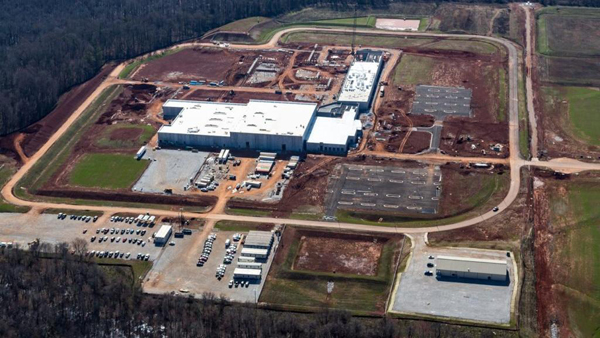
Initial personnel and special processing equipment are taking occupancy in GE Aviation’s new factory complex in Huntsville-annexed Limestone County – America’s first center for mass-producing silicon carbide materials used to manufacture ceramic matrix...

Initial personnel and special processing equipment are taking occupancy in GE Aviation’s new factory complex in Huntsville-annexed Limestone County – America’s first center for mass-producing silicon carbide materials used to manufacture ceramic matrix composites.
The $200 million center is comprised of two adjacent factories on 100 acres. One factory will produce SiC ceramic fiber, the raw material used to make the unidirectional CMC tape being produced in the neighboring factory. The CMC tape will be used to fabricate CMC components for jet engines and land-based gas turbines.
The plants are critical in enabling GE Aviation to produce CMC components in large volume.
The fiber plant is modeled after the SiC fiber factory of NGS Advanced Fibers in Japan, a joint company of Nippon Carbon, GE and Safran of France. The expanding NGS operation is the only plant in the world today producing CMC fiber on a large scale. GE is licensing from NGC its fiber-producing technology.
“The equipment coming into our Huntsville factories is unique,” said Jon Lyford, plant manager for GE Aviation’s Huntsville operations. GE Aviation has been hiring engineers outside the traditional areas of aerospace engineering.
“We are hiring experts in the area of process-based manufacturing found in the oil and gas, chemical, and the consumer packaged goods industries,” Lyford said. “Managing the production of CMC materials requires a special skillset. We have several key leadership positions in place, and we begin hiring hourly workers toward the end of the year.”
GE Aviation expects to deliver its first CMC materials from Huntsville by mid-2018. Currently, the Huntsville team is at 40 employees and growing. The company anticipates about 150 employees in the plants by the end of 2018. About 300 employees are expected to run the operation at peak production.
The demand for CMCs is expected to grow tenfold over the next decade, driven by rising jet engine production rates. Each new leading edge aviation propulsion engine produced by CFM International (50/50 joint company of GE and Safran of France) has 18 CMC turbine shrouds, which are stationary parts in the high-pressure turbine that direct air and ensure turbine blade efficiency.
CFM is expected to deliver about 500 LEAP engines this year, 1,200 in 2018 and 1,800 in 2019. In addition, CMCs are being used in the combustor and high-pressure turbine section of the new GE9X engine under development for the Boeing 777X twin-aisle aircraft. Almost 700 GE9X engines are on order today, with the aircraft entering service by 2020.
GE is also incorporating CMC components in advanced military engines, including the GE3000 for the U.S. Army. GE’s advanced turboshaft demonstrator FATE — which stands for “Future Affordable Turbine Engine” and is also for the Army — increases the use of hot-section CMCs to achieve aggressive fuel efficiency, power-to-weight ratio and lower maintenance cost goals. CMCs are currently being evaluated for upgrades to existing engines like the highly popular T700 helicopter engine.
The fiber plant is supported by $21.9 million in funding from the U.S. Air Force Research Lab Title III Office. Once the Huntsville plant is operational, it will sell fiber to the Department of Defense, GE businesses, Herakles (Safran) and other outside customers subject to U.S. regulations. It will also be the first U.S.-based factory to produce SiC ceramic fiber on a large industrial scale. The two other NGS partners will ultimately have the opportunity to become equity partners in the Huntsville plant.
The use of lightweight, heat-resistant CMCs in the hot section of GE jet engines is a breakthrough for the jet propulsion industry. CMCs comprise SiC ceramic fibers in a SiC matrix, enhanced by proprietary coatings.
With one-third the density of metal alloys, these ultra-lightweight CMCs reduce the overall engine weight. Further, their high-temperature properties greatly enhance engine performance, durability and fuel economy. CMCs are far more heat-resistant than metal alloys, thus requiring less cooling air in the engine’s hot section. By using this air instead in the engine flow path, an engine runs more efficiently.
GE Aviation, an operating unit of GE, is a world-leading provider of jet engines, components and integrated systems for commercial and military aircraft. GE Aviation has a global service network to support these offerings.